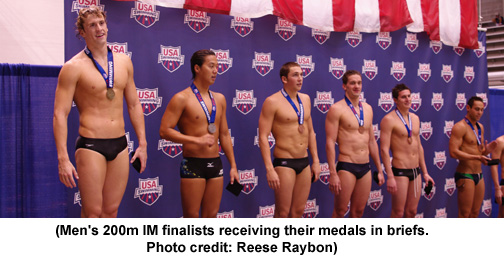FINA DOESN'T QUITE GET IT RIGHT
Brent S. Rushall, Ph.D.,R.Psy.
San Diego State University
ęSports Science Associates
Spring Valley, California
September 29, 2009
![]()
Even now, the suit problem is not completely solved. In 1995-96 when "Jammers" first came out, Speedo claimed them to be performance-enhancing and many swimmers wore them at the Atlanta Games ostensibly to gain an advantage. Whether Speedo's claims were truthful or backed by only their "evidence" is not known. Then when the 200 IM Men's finalists at the recent US nationals (8/8/2009) elected not to wear bodysuits, they all wore briefs or short-legged suits (see Figure 1 below). That suggested those swimmers considered suits must be brief to "make the playing field level" [sorry for the mixed metaphor]. So there is the possibility that even the new swimsuit limitations of down-to-the-knees still does not make the sport truly clean because it is seems to be a return to the "performance-enhancement" that existed in the mid-1990s.
One hope is that FINA's "scientific committee" looking at the suit problem will come up with criteria/rules that will be accepted by FINA which will make materials particularly absorbent. With sufficient absorbency and other characteristics in suit fabrics/materials, hopefully it will come to the point where the more material worn by swimmers the greater will be the degradation in swimming performances. In other words, more coverage will be a performance liability and have no assistive properties or value. That should be the motivation to stop looking at swimsuits as an avenue for performance enhancement.
It is a pity that one has to resort to "hope" to correct the errors of this sport.

Figure 1. Picture reproduced from USA Swimming web site.
Return to Table of Contents for The Bodysuit Problem.
![]()